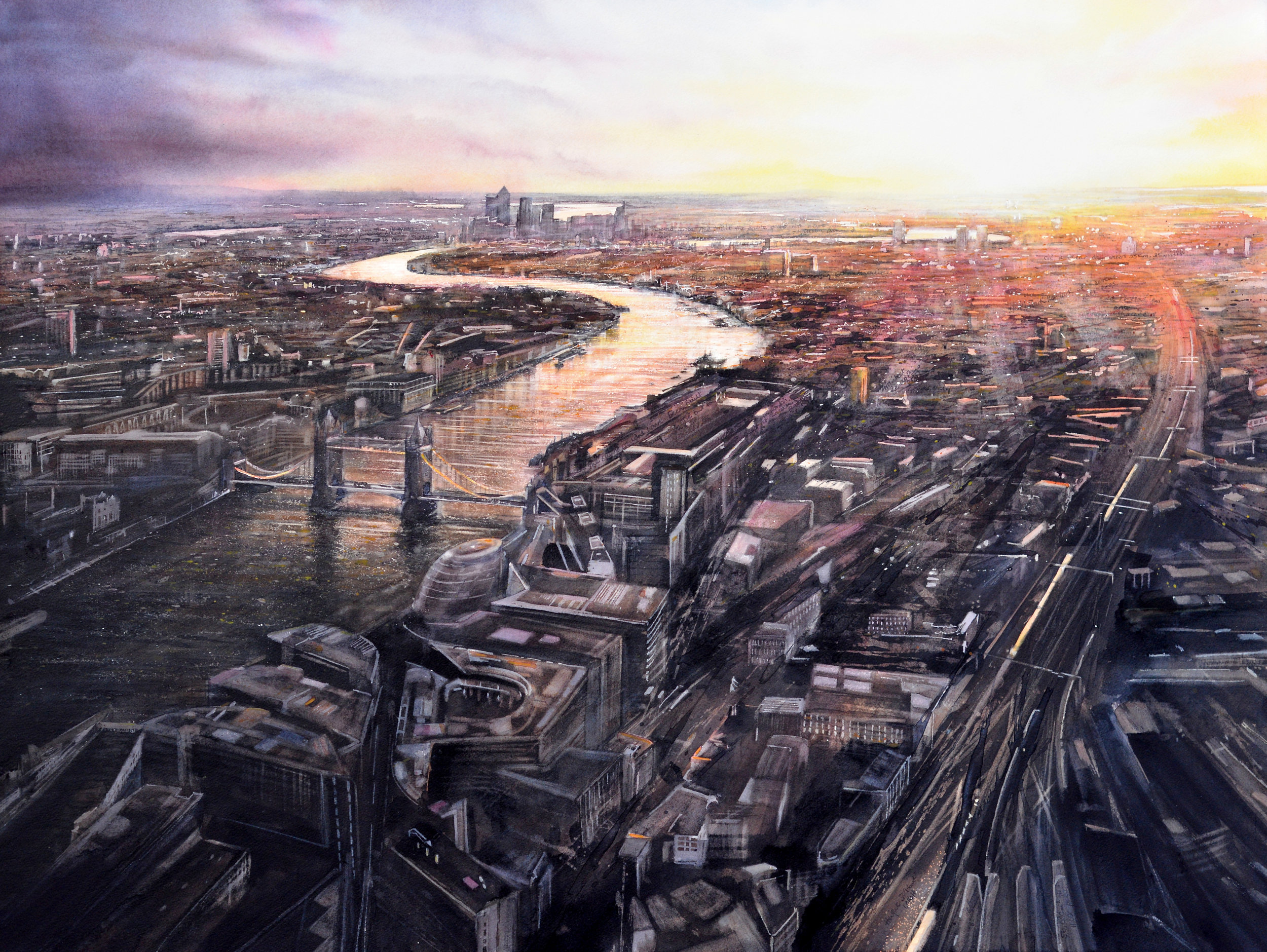I think of a painting as a gift to the viewer.
When seen from a distance my work appears to be a realistic representation of a subject. As you get closer the vision changes, mark making becomes more evident, until up close the painting reveals itself as a collection of almost abstract elements.
I became aware, as the size of my work increased, that in close proximity the whole painting can exceed the visual field. With the idea of a painting as a gift in mind, I thought of almost hiding relevant text, written by hand in watercolour, amongst the painted marks. This would only be included in the larger work, as in smaller paintings it would be intrusive. The writing allows the painting to ‘give again’, adding interest and increasing the value of the viewer’s experience one more time.
Excerpts from the catalogue:
From The Eye - watercolour - image 82 x 75cm
On a cold November afternoon the view from the London Eye embraces a huge cityscape of geometric concrete, metal and stone. With a sudden break in the clouds and a blast of sunlight, it transforms the subject into a thing of beauty. It throws everything into silhouette, unifying and diffusing colours, softening edges and reducing detail.
“Ne’er saw I, never felt, a calm so deep!
The river glideth at his own sweet will:
Dear God! the very houses seem asleep;
And all that mighty heart is lying still!”
-William Wordsworth
Sunrise from The Shard - watercolour - image 83 x 110cm
The Shard, completed in 2012 and standing at 310 metres (1016 ft), is the tallest building in Western Europe. On a clear day from the upper viewing gallery, on level 72, you can see for approximately 55 kilometres (35 miles) in each direction, affording the most magnificent views over the whole of London. Looking east, the Thames meanders under Tower Bridge towards the Thames Barrier, swaying rhythmically from right to left. Adding the pinks and golds of sunrise, the monotone city of the night comes to life.
“I thought of London spread out in the sun,
Its postal districts packed like squares of wheat.”
– Philip Larkin
Reclaim Recycle - watercolour - image 100 x 74cm
Drawn by the red of decaying paint, struck by the ambiguity of this find washed up and ravaged by the sea at Spittal in Northumberland, I had found a subject. Entropy describes the process by which every structure eventually breaks down into its constituent parts. This painted metal structure was crafted from the earth and the sea will reclaim and recycle it.
“...But doth suffer a sea-change
Into something rich and strange.”
– William Shakespeare
Tidal Rhythms - watercolour - image 82 x 110cm
Stackhouse Cove in West Cornwall is home to the widest range of seaweed species ever recorded in Britain, thriving in warm coastal waters, influenced by the Gulf Stream and extensive rocky reefs. It was the subject of research by marine biologist John Stackhouse in the 18th century. John’s wife Lady Susannah Acton suffered poor health and as it was believed that the sea-air and seaweed itself had healing properties, John had a bath chipped out of the rocks so that she could bathe in the healing water and weeds. The bath can still be found today. The shore is criss-crossed with spectacular deep gullies which provide their own micro-habitat. At low tide they also behave as a giant protective wall against the ocean, a place of solitude and safety. It’s very quiet and peaceful and feels protected from the roar, the deafening silence of the sea. The ebb and flow, the rise and fall of the tide becomes almost hypnotic.
“Cold currents thrid, and turn to rhythmic tidal lyres.”
– Thomas Hardy
Littoral Drift - watercolour - image 80 x 110cm
Prussia Cove in South West Cornwall is accessible by foot from the coast path. It consists of four tiny bays connected by rocky outcrops. The area is steeped in history and folklore, named after the 18th century ship wrecker and smuggler John Carter (born 1738), also known as the ‘King of Prussia’. Standing at the rocky edge you can be surrounded on three sides by the sea, giving a sense of the swell gliding by. The littoral zone extends from the high water mark to shoreline areas that are permanently submerged. The natural movement of the littoral along the coast is called the littoral drift.
“Between the salt water and the sea’s strand”
– Anon
Sunlight and Shadows - watercolour - image 80 x 92cm
Old Harry Rocks is a name given to a chalk stack found below the cliffs at Ballard, east of Studland, marking the eastern end of the Jurassic Coast. There are two stories regarding the naming of the rocks. The name ‘Harry’ or ‘Old Harry’ were once familiar names for the devil, like the old saying, ‘to play Old Harry’ which means ’to ruin or destroy’. He is said to have taken a nap on the rocks! The other explanation links the name to the infamous pirate Harry Paye, who used to store his contraband nearby and use the rocks to lie in wait for passing ships. Either way, Old Harry Rocks were so-called as a warning to keep shipping well clear! The blinding sunlight reflecting off the chalk, modelled by softly contrasting shadows give shape and form to the cliffs.
“...for let the form of an object be what it may, - light, shade and perspective will always make it beautiful.”
– John Constable







